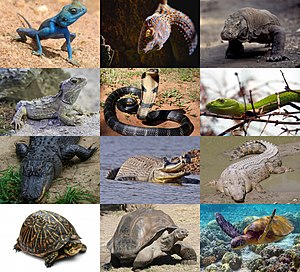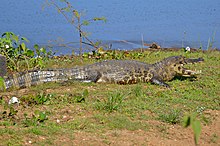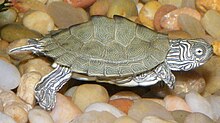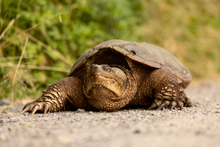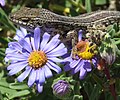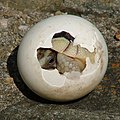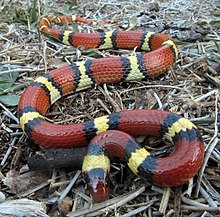Template:Transclude excerpts as random slideshow/testcases/Portal:Reptiles
Source: Wikipedia, the free encyclopedia.
Portal maintenance status: (June 2018)
automated editing software. Learn how to update the maintenance information here . |
Inroduction
Reptilians by saurian clade listed in top-to-bottom order: six lepidosaurs and six archelosaurs.
amniotic development. Living reptiles comprise four orders: Testudines (turtles), Crocodilia (crocodilians), Squamata (lizards and snakes), and Rhynchocephalia (the tuatara). As of May 2023, about 12,000 living species of reptiles are listed in the Reptile Database. The study of the traditional reptile orders, customarily in combination with the study of modern amphibians, is called herpetology.
Reptiles have been subject to several conflicting
Dinosauria are more closely related to living crocodilians than to other reptiles, and are thus nested among reptiles from an evolutionary perspective. Many cladistic systems therefore redefine Reptilia as a clade (monophyletic group) including birds, though the precise definition of this clade varies between authors. Others prioritize the clade Sauropsida, which typically refers to all amniotes more closely related to modern reptiles than to mammals
.
The earliest known proto-reptiles originated around 312 million years ago during the
dinosaurs alongside many species of crocodyliforms, and squamates (e.g., mosasaurs). Modern non-bird reptiles inhabit all the continents except Antarctica. (Full article...
)
Read more...
Reptile types
-
Image 1reflex bleeding, and the ability to sacrifice and regrow their tails. (Full article...)Image 2scales made of keratin, the material of hair, horns, and claws. The carapace bones develop from ribs that grow sideways and develop into broad flat plates that join up to cover the body. Turtles are ectotherms or "cold-blooded", meaning that their internal temperature varies with their direct environment. They are generally opportunistic omnivores and mainly feed on plants and animals with limited movements. Many turtles migrate short distances seasonally. Sea turtles are the only reptiles that migrate long distances to lay their eggs on a favored beach.)
Turtles have appeared in myths and folktales around the world. Some terrestrial and freshwater species are widely kept as pets. Turtles have been hunted for their meat, for use in traditional medicine, and for their shells. Sea turtles are often killed accidentally as bycatch in fishing nets. Turtle habitats around the world are being destroyed. As a result of these pressures, many species are extinct or threatened with extinction. (Full article...Image 3extant species are the American alligator (A. mississippiensis) and the Chinese alligator (A. sinensis). Additionally, several extinct species of alligator are known from fossil remains. Alligators first appeared during the late Eocene epoch about 37 million years ago.)
The name "alligator" is likely an anglicized form of el lagarto, the Spanish term for "the lizard", which early Spanish explorers and settlers in Florida called the alligator. Early English spellings of the name included allagarta and alagarto. (Full article...Image 4reclusive animals. Tortoises are the longest-living land animals in the world, although the longest-living species of tortoise is a matter of debate. Galápagos tortoises are noted to live over 150 years, but an Aldabra giant tortoise named Adwaita may have lived an estimated 255 years. In general, most tortoise species can live 80–150 years.)
Tortoises are placid and slow-moving, with an average walking speed of 0.2–0.5 km/h.[citation needed] (Full article...Image 5
The tuatara (Sphenodon punctatus) is a species of reptile endemic to New Zealand. Despite its close resemblance to lizards, it is part of a distinct lineage, the order Rhynchocephalia. The name tuatara is derived from the Māori language and means "peaks on the back".
The single extant species of tuatara is the only surviving member of its order, which was highly diverse during the Mesozoic era. Rhynchocephalians first appeared in the fossil record during the Triassic, around 240 million years ago, and reached worldwide distribution and peak diversity during the Jurassic, when they represented the worlds dominant group of small reptiles. Rhynchocephalians underwent a great decline during the Cretaceous with their youngest records outside New Zealand dating to the Paleocene. Their closest living relatives are squamates (lizards and snakes). Tuatara are of interest for studying the evolution of reptiles.
Tuatara are greenish brown and grey, and measure up to 80 cm (31 in) from head to tail-tip and weigh up to 1.3 kg (2.9 lb) with a spiny crest along the back, especially pronounced in males. They have two rows of teeth in the upper jaw overlapping one row on the lower jaw, which is unique among living species. They are able to hear, although no external ear is present, and have unique features in their skeleton. (Full article...)Image 6critically endangered. (Full article...)Image 7Full article...)Image 8Full article...)Image 9Ma ago. The diversity of modern snakes appeared during the Paleocene epoch (c. 66 to 56 Ma ago, after the Cretaceous–Paleogene extinction event). The oldest preserved descriptions of snakes can be found in the Brooklyn Papyrus.)
Most species of snake are nonvenomous and those that have venom use it primarily to kill and subdue prey rather than for self-defense. Some possess venom that is potent enough to cause painful injury or death to humans. Nonvenomous snakes either swallow prey alive or kill by constriction. (Full article...Image 10alligatorid belonging to the subfamily Caimaninae, one of two primary lineages within the Alligatoridae family, the other being alligators. Caimans inhabit Mexico and Central and South America from marshes and swamps to mangrove rivers and lakes. They have scaly skin and live a fairly nocturnal existence. They are relatively small-sized crocodilians with an average maximum weight of 6 to 40 kg (13 to 88 lb) depending on species, with the exception of the black caiman (Melanosuchus niger), which can grow more than 4 m (13 ft) in length and weigh in excess of 1,000 kg (2,200 Ib). The black caiman is the largest caiman species in the world and is found in the slow-moving rivers and lakes that surround the Amazon basin. The smallest species is the Cuvier's dwarf caiman (Paleosuchus palpebrosus), which grows to 1.2 to 1.5 m (3.9 to 4.9 ft) long. There are six different species of caiman found throughout the watery jungle habitats of Central and Southern America. The average length for most of the other caiman species is about 2 to 2.5 m (6.6 to 8.2 ft) long.)
Caimans are distinguished from alligators, their closest relatives, by a few defining features: a lack of a bony septum between the nostrils, ventral armor composed of overlapping bony scutes formed from two parts united by a suture, and longer and sharper teeth than alligators, plus caimans tend to be more agile and crocodile-like in their movements. The calcium rivets on caiman scales make their hides stiffer.
Several extinct forms are known, including Purussaurus, a giant Miocene genus that grew to 12 m (39 ft) and the equally large Mourasuchus, which had a wide duck-like snout. (Full article...Selected Crocodilia articles
-
Image 1incubation. Both parents protect the young for up to one year. They feed on insects, and adults prey on fish, reptiles, birds and mammals.)
The mugger crocodile evolved at least 4.19 million years ago and has been a symbol for the fructifying and destructive powers of the rivers since the Vedic period. It was first scientifically described in 1831 and is protected by law in Iran, India and Sri Lanka. Since 1982, it has been listed as Vulnerable on the IUCN Red List. Outside protected areas, it is threatened by conversion of natural habitats, gets entangled in fishing nets and is killed in human–wildlife conflict situations and in traffic accidents. (Full article... -
Image 2Amazon and Orinoco Basins. It is the second-smallest species of the family Alligatoridae, the smallest being Cuvier's dwarf caiman, also from tropical South America and in the same genus. An adult typically grows to around 1.2 to 1.6 m (3.9 to 5.2 ft) in length and weighs between 9 and 20 kg (20 and 44 lb). Exceptionally large males can reach as much as 2.3 m (7.5 ft) in length and 36 kg (79 lb) in weight. (Full article...)Image 3crocodilian in the family Alligatoridae found in eastern and central South America, including southeastern Brazil, northern Argentina, Uruguay, Paraguay, and Bolivia. It is the second largest caiman and the third largest alligatorid. It is found mostly in freshwater marshes, swamps, and mangroves, usually in still or very slow-moving waters. It will often use man-made cow ponds. (Full article...)Image 4crocodilian in the family Alligatoridae. It is brownish-, greenish-, or yellowish-gray colored and has a spectacle-like ridge between its eyes, which is where its common name come from. It grows to a length of 1.4–2.5 m (4 ft 7 in – 8 ft 2 in) and a weight of 7–40 kg (15–88 lb), with males being both longer and heavier than females. Its diet varies seasonally, commonly consisting of crabs, fish, small mammals, amphibians and snails. Breeding occurs from May to August and 14–40 eggs are laid in July and August. This crocodilian has a large range and population; it is native to much of Latin America, and has been introduced to the United States, Cuba, and Puerto Rico. (Full article...)Image 5Specimen in Bazoulé, Burkina Faso
The West African crocodile, desert crocodile, or sacred crocodile (Crocodylus suchus) is a species of crocodile related to — and often confused with — the larger and more aggressive Nile crocodile (C. niloticus). (Full article...)Image 6eggs. The females guard the nests and young for several years. (Full article...)Image 7critically endangered on the IUCN Red List since 2007. (Full article...)Image 8habitat loss. It is regarded as dangerous to humans.)
The saltwater crocodile is the largest living reptile. Males can grow up to a weight of 1,000–1,500 kg (2,200–3,300 lb) and a length of 6 m (20 ft), rarely exceeding 6.3 m (21 ft). Females are much smaller and rarely surpass 3 m (9.8 ft). It is also called the estuarine crocodile, Indo-Pacific crocodile, marine crocodile, sea crocodile, and, informally, the saltie. A large and opportunistic hypercarnivorous apex predator, they ambush most of their prey and then drown or swallow it whole. They will prey on almost any animal that enters their territory, including other predators such as sharks, varieties of freshwater and saltwater fish including pelagic species, invertebrates such as crustaceans, various amphibians, other reptiles, birds, and mammals, including humans. (Full article...Image 9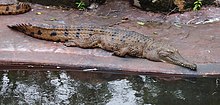
The freshwater crocodile (Crocodylus johnstoni), also known as the Australian freshwater crocodile, Johnstone's crocodile or the freshie, is a species of crocodile endemic to the northern regions of Australia. Unlike their much larger Australian relative, the saltwater crocodile, freshwater crocodiles are not known as man-eaters, although they bite in self-defence, and brief, nonfatal attacks have occurred, apparently the result of mistaken identity. (Full article...)Image 10Mato Grosso, Brazil
The yacare caiman (Caiman yacare), also known commonly as the jacare caiman, Paraguayan caiman, piranha caiman, red caiman, and southern spectacled caiman, is a species of caiman, a crocodilian in the family Alligatoridae. The species is endemic to Argentina, Bolivia, Brazil, and Paraguay. Brown in color and covered with dark blotches, males grow to a total length (including tail) of 2–3 m (6 ft 7 in – 9 ft 10 in) and weigh around 40–50 kg (88–110 lb); while females grow to 1.4 m (4 ft 7 in) long and about 15–20 kg (33–44 lb). Typical habitats of this caiman include lakes, rivers, and wetlands. Its diet primarily consists of aquatic animals, such as snails, and occasionally land vertebrates. Mating occurs in the rainy season and eggs hatch in March, with young fending for themselves as soon as they hatch. The yacare caiman was hunted heavily for its skin to use for leather in the 1980s, which caused its population to decrease significantly. However, trading restrictions placed since have caused its population to increase. Its population in the Pantanal is about 10 million, and it is listed as least concern on the IUCN Red List. (Full article...)Image 11Lago Enriquillo in the Dominican Republic.)
The American crocodile is one of the largest crocodile species. Males can reach lengths of 6.1 m (20 ft 0 in), weighing up to 907 kg (2,000 lb). On average, mature males are more in the range of 2.9 to 4.1 m (9 ft 6 in to 13 ft 5 in) in length weighing up to about 400 kg (880 lb). As with other crocodile species, females are smaller, rarely exceeding 3.8 m (12 ft 6 in) in length even in the largest-bodied population. (Full article...Image 12critically endangered and already extirpated from many regions. Its other common names include Siamese freshwater crocodile, Singapore small-grain, and soft-belly. (Full article...)Image 13Full article...)Image 14mating season and young vocalize to communicate with their parents and other juveniles. Captive specimens have reached age 70, and wild specimens can live past 50.)
Living in bodies of fresh water, the Chinese alligator's range is restricted to six regions in the province of Anhui, as well as possibly the provinces of Jiangsu and Zhejiang. Originally living as far away from its current range as Japan, the species previously had a wide range and population, but beginning in 6000 BC, multiple threats, such as habitat destruction, caused the species' population and range to decline. The population in the wild was about 1,000 in the 1970s, decreased to below 130 in 2001, and grew after 2003, with its population being about 300 as of 2017. Listed as critically endangered by the International Union for Conservation of Nature, multiple conservation actions have been taking place for this species.
The Chinese alligator has been a part of Chinese literature since the third century. In the late 13th century, Marco Polo became the first person outside of China to write about it. In some writings, the Chinese alligator has been associated with the Chinese dragon. Many pieces of evidence suggest that the Chinese alligator was an inspiration for the Chinese dragon. (Full article...Image 15sympatric American crocodile by its broader snout, with overlapping jaws and darker coloration, and is less tolerant of saltwater but more tolerant of cooler climates than the American crocodile, which is found only in tropical and warm subtropical climates.)
American alligators are apex predators and consume fish, amphibians, reptiles, birds, and mammals. Hatchlings feed mostly on invertebrates. They play an important role as ecosystem engineers in wetland ecosystems through the creation of alligator holes, which provide both wet and dry habitats for other organisms. Throughout the year (in particular during the breeding season), American alligators bellow to declare territory, and locate suitable mates. Male American alligators use infrasound to attract females. Eggs are laid in a nest of vegetation, sticks, leaves, and mud in a sheltered spot in or near the water. Young are born with yellow bands around their bodies and are protected by their mother for up to one year. This species displays parental care, which is rare for most reptiles. Mothers protect their eggs during the incubation period, and moves the hatchlings to the water using her mouth. (Full article...Image 16least concern for extinction according to the International Union for Conservation of Nature.)
The species has a fossil record in Guatemala. (Full article...Image 17Least Concern". (Full article...)Image 18cooperative hunting behavior, and can be taught tricks, suggesting intelligence.)
The Cuban crocodile is listed as Critically Endangered by the International Union for Conservation of Nature. Once spread across the Caribbean, its range has dwindled to including only the Zapata Swamp and Isla de la Juventud, due to hunting by humans. Captive breeding projects are in place to help the species recover.
The species fossil record reveals it had at one point a greater range, with fossil remains being found in The Bahamas, Hispaniola (in the Dominican Republic), and the Cayman Islands. (Full article...Image 19dynamite fishing. Conservation methods are being taken by the Dutch/Filipino Mabuwaya foundation, the Crocodile Conservation Society and the Zoological Institute of HerpaWorld in Mindoro island. It is strictly prohibited to kill a crocodile in the country, and it is punishable by law. (Full article...)Image 20eggs; these are guarded by the females and males, making the Nile crocodiles one of few reptile species whose males contribute to parental care. The hatchlings are also protected for a period of time, but hunt by themselves and are not fed by the parents. (Full article...)Image 21least concern. (Full article...)Image 22extant (living) species of crocodile. (Full article...)Image 23Conservation Dependent. Overall a little-known species, it was not researched in any detail until the 1980s, when the leather-trade had already taken its toll. It is a dangerous species to humans, and attacks have occurred in the past. (Full article...)Selected lizard articles
-
Image 1Santa Isabel Island, San Jorge Island (Solomon Islands) and Bourgainville Island (Papua New Guinea). (Full article...)
-
Image 2Middle Africa. (Full article...)
-
Image 3

The Knysna dwarf chameleon (Bradypodion damaranum) is a species of dwarf chameleon in the Bradypodion ("slow footed") genus that is endemic to South Africa. It is a forest dweller, found only in a limited range in the afromontane forests near Knysna, South Africa, and in certain surrounding areas. (Full article...) -
Image 4Draco, this species has the ability to glide using winglike lateral extensions of skin called patagia.)
The species is exclusively arboreal. (Full article... -
Image 5oviparous. They are notable for relying solely on dewlap-mediated communication, instead of conveying signals via both headbobbing and employing dewlaps, as is typical for lizards with dewlaps. (Full article...)
-
Image 6)
-
Image 7insectivorous, rarely exceeds 15 cm (5.9 in) in length, has large, lidless eyes with elliptical pupils, and purple or tan-colored skin with black spots, often with stripes on the tail. Its belly or undersides are somewhat translucent. What impact this gecko has on native wildlife in the regions to which it has been introduced is unknown.)
In many parts of the world, the range of H. turcicus is increasing, and unlike many other reptiles, it appears to be highly resistant to pesticides. The increase may be explained as a consequence of having few predators in places where it has been introduced, and also of its tendency to take shelter in the cracks and unseen areas of human homes, for example inside walls. Reliance on human habitation has thus contributed to the species' proliferation, similar to rodents. In some Eastern Mediterranean countries such as Turkey and Cyprus, harming H. turcicus is taboo due to its benign nature, and it is often kept as a house pet. (Full article... -
Image 8
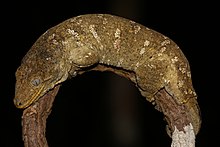
Rhacodactylus leachianus, commonly known as the New Caledonian giant gecko, Leach's giant gecko, leachianus gecko, or simply Leachie, is the largest living species of gecko and a member of the family Diplodactylidae. It is native to most of New Caledonia. (Full article...) -
Image 9Eastern Cape Province of South Africa. (Full article...)Image 10

The Alfa Romeo Iguana is a concept car produced by Alfa Romeo in 1969. It was designed by Giorgetto Giugiaro at Italdesign. (Full article...)Image 11Full article...)Image 12endemic to Fynbos in South Africa's Eastern Cape. As in several species of chameleons in the genus Bradypodion, the Smith's dwarf chameleon can use its color-changing ability to actively camouflage itself depending on the vision of the specific predator species (for example, bird or snake) by which it is being threatened. (Full article...)Image 13
The Namaqua dwarf chameleon or the western dwarf chameleon (Bradypodion occidentale) occurs in beach vegetation, along the west coast of South Africa and Namibia. (Full article...)Image 14
The desert monitor (Varanus griseus) is a species of monitor lizard of the order Squamata found living throughout North Africa and Central and South Asia. The desert monitor is carnivorous, feeding on a wide range of vertebrates and invertebrates. (Full article...)Image 15endemic to South Africa. (Full article...)Image 16tubercules are enlarged and give the species a spiny armoured appearance.)
The species was first described by Carl Linnaeus in 1758. It is also known as moorish gecko, crocodile gecko, European common gecko, and, regionally, as osga (in Portuguese), salamanquesa (in Spanish) and dragó (in Catalan). (Full article...Image 17above sea level, although its distribution is poorly known. (Full article...)Image 18
Pachydactylus is a genus of insectivorous geckos, lizards in the family Gekkonidae. The genus is endemic to Africa, and member species are commonly known as thick-toed geckos. The genus also displays rich speciation, having 58 distinct species identified when compared to other closely related gecko genera like Rhoptropus, most of which have emerged since 35Ma. It has been suggested that the reason for this rich speciation not from adaptive radiation nor nonadaptive radiation, but that the genus represents a clade somewhere between the two drivers of speciation. P. bibronii geckos have been used by NASA as animal models for experimentation. (Full article...)Image 19
Draco timoriensis, also known as the Timor flying dragon, is a species of lizard endemic to the Lesser Sunda Islands in Indonesia and East Timor. (Full article...)Image 20Cosymbotus. There were thirteen described species in the genus Ptychozoon. (Full article...)Image 21cryptic species complexes are found. Geckos like to live in and out of houses. They have been introduced to Australia.)
This species is closely related to the genus Gehyra, which belongs to the same family in Gekkonidae.
The species are typically known as house geckos, due to their readiness to adapt to and coexist with humans, and can be easily encountered in human habitations. (Full article...Image 22parthenogenic – all individuals are female and lay eggs that hatch without requiring male fertilisation.)
In Hawaii, the species is thought to be a long-term resident. Formerly considered a house gecko, it has been displaced to natural habitats by the more recently arrived common house gecko. In Florida and Georgia, it has become established as an invasive species of concern. (Full article...Image 23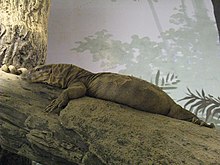
The yellow monitor (Varanus flavescens) or golden monitor is a monitor lizard native to South Asia. (Full article...)Image 24only living species in the family Lanthanotidae and it is related to the true monitor lizards. (Full article...)Image 25Sonoran and Mojave Deserts of the Southwestern United States and northwestern Mexico, as well as on several Gulf of California islands. (Full article...)Selected turtle articles
-
Image 1
The six-tubercled Amazon River turtle or six-tubercled river turtle (Podocnemis sextuberculata) is a species of turtle in the family Podocnemididae.
It is found in the Amazon basin in Brazil, Colombia, Peru and possibly Ecuador. (Full article...) -
Image 2South American river turtles.)
Podocnemis unifilis is a type of side-necked turtles, so called because they do not pull their heads directly into their shells, but rather bend their necks sideways to tuck their heads under the rim of their shells. Side-neck turtles are classified as members of the suborder Pleurodira. (Full article...Image 3softshell turtle in the family Trionychidae. The species is endemic to Southeast Asia. (Full article...)Image 4Guangde County, and Jing County. (Full article...)Image 5
The northern spiny softshell turtle (Apalone spinifera spinifera) is a subspecies of soft-shelled turtle in the family Trionychidae. The subspecies is native to the United States and can be found from Montana at the western edge of its range to Vermont and Quebec on the eastern edge. Introduced populations have also been found in Massachusetts, New Jersey, Arizona, and Virginia. (Full article...)Image 6
The Tabasco mud turtle (Kinosternon acutum), commonly known as pochitoque in Tabasco, Mexico, is a small turtle which belongs to the family Kinosternidae. It can be found in central Veracruz, Tabasco, northern Guatemala and Belize. This turtle lives in small streams, marshes and ponds. Its feeding habits are mainly carnivorous and it is a nocturnal animal. Although this turtle doesn't have a wide range it can be common at some sites. In Tabasco this turtle is an important part of its popular culture as well as being an ingredient in Tabasco's gastronomy in spite of its special protected status. (Full article...)Image 7The northern spotted box turtle (Terrapene nelsoni klauberi ), also commonly known as Klauber's box turtle and Klauber's spotted box turtle, is a species of turtle in the family Emydidae. (Full article...)Image 8
Cagle's map turtle (Graptemys caglei) is a species of turtle in the family Emydidae. The species is endemic to Texas, where it is native to the Guadalupe, San Antonio, and San Marcos Rivers. (Full article...)Image 9
The Gulf Coast box turtle (Terrapene carolina major) is the largest subspecies of the common box turtle (Terrapene carolina). (Full article...)Image 10plastron and a long, thick tail. By contrast, sexually mature females possess a flat plastron and have a tail that is noticeably shorter and thinner than that of mature males. Mature males also have a dark iris and face; females typically have a yellow or orange iris and a similarly coloured face that is distinctly lighter than the males'. Juveniles appear female-like in this regard, and at maturity males begin to develop darker features.)
Spotted turtles are aquatic omnivores that inhabit a variety of semi-aquatic or in other words, shallow, fresh-water areas such as flooded forests, marshes, wet meadows, bogs and woodland streams in southern Canada (Ontario) and the eastern US: the eastern Great Lakes and east of the Appalachian Mountains. (Full article...Image 11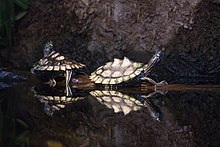
The ringed map turtle or ringed sawback (Graptemys oculifera) is a species of turtle in the family Emydidae endemic to the southern United States. (Full article...)Image 12mud turtle in the Kinosternidae family.)
It is endemic to north-eastern Mexico. It is found in the states of Chihuahua, Coahuila, and Durango. (Full article...Image 13Thetype specimens. (Full article...)Image 14Pseudemys rubriventris, the Northern red-bellied turtle)- Red-bellied short-necked turtle, a species of turtle in the family Chelidae found in tropical Australia and Papua New Guinea
(Full article...Image 15Full article...)Image 16
The Chinese box turtle (simplified Chinese: 食蛇龟; traditional Chinese: 食蛇龜; pinyin: shíshéguī; lit. 'Snake-eating turtle'), also known as the yellow-margined box turtle, or golden-headed turtle, is a species of Asian box turtle. Taxonomically, it is called Cuora flavomarginata. (Full article...)Image 17The )Image 18Chelydra serpentina, native to eastern North America)- Elseya dentata, native to Australia
(Full article...Image 19Queretaro, San Luis Potosí, Sinaloa, Sonora, Tamaulipas and Zacatecas, where they inhabit moist environments, such as shallow ponds, lakes, rivers or intermediate temp. tropical forest areas. (Full article...)Image 20TheCritically Endangered on the IUCN Red List due to its restricted range and the heavy level of exploitation it receives. (Full article...)Image 21
Hoge's sideneck turtle (Ranacephala hogei) is a species of turtle in the family Chelidae. It is the only member of the genus Ranacephala. The species is endemic to the eastern Atlantic Forest of Brazil, primarily in the Carangola River of Minas Gerais and Paraíba do Sul River, Rio de Janeiro. The most documented population resides in the midsection of the Carangola River with an estimated population of less than 2000.
The Official Brazilian Red List considers Hoge's sideneck turtle to be the most endangered turtle species within Brazil. It was listed by the Turtle Survival Coalition as one of the world "25 Turtles in Trouble" for 2018. (Full article...)Image 22
The West African mud turtle (Pelusios castaneus), also known as the West African side-necked turtle or swamp terrapin, is a species of turtle in the family Pelomedusidae.
Pelusios castaneus is a freshwater species and is endemic to West and Central Africa. (Full article...)Image 23Snapping turtle crossing the trail at John Heinz NWR
The common snapping turtle (Chelydra serpentina) is a species of large freshwater turtle in the family Chelydridae. Its natural range extends from southeastern Canada, southwest to the edge of the Rocky Mountains, as far east as Nova Scotia and Florida. The present-day Chelydra serpentina population in the Middle Rio Grande, suggests that common snapping turtle has been present in this drainage since at least the seventeenth century and is likely native. The three species of Chelydra and the larger alligator snapping turtles (genus Macrochelys) are the only extant chelydrids, a family now restricted to the Americas. The common snapping turtle, as its name implies, is the most widespread.
The common snapping turtle is noted for its combative disposition when out of the water with its powerful beak-like jaws, and highly mobile head and neck (hence the specific epithet serpentina, meaning "snake-like"). In water, it is likely to flee and hide underwater in sediment. The common snapping turtle has a life-history strategy characterized by high and variable mortality of embryos and hatchlings, delayed sexual maturity, extended adult longevity, and iteroparity (repeated reproductive events) with low reproductive success per reproductive event.
Females, and presumably also males, in more northern populations mature later (at 15–20 years) and at a larger size than in more southern populations (about 12 years). Lifespan in the wild is poorly known, but long-term mark-recapture data from Algonquin Park in Ontario, Canada, suggest a maximum age over 100 years. (Full article...)Image 24Rafetus swinhoei), although some Vietnamese biologists asserted that R. leloii is a distinct species. If the two taxa are to be considered distinct, R. leloii may be considered extinct.)
The last known turtle, affectionately known to locals as "Cụ Rùa", meaning “great grandfather turtle” in Vietnamese, was reported dead on 19 January 2016. A local man saw the body of the turtle floating in the water and reported it to the authorities. The last time the turtle was spotted alive was on 21 December 2015. (Full article...Image 25Trionyx triunguis (the two typically require in-hand examination to be separated).)
The Euphrates softshell turtle is an endangered species that primarily is threatened by habitat loss and alteration, especially the building of dams, but to lesser extent also pollution and killing by fishermen. (Full article...Selected pictures
-
Image 1White-headed dwarf gecko
-
Image 2Barracudasauroides
-
Image 3Italian wall lizard
-
Image 4Thamnophis elegans terrestris at Western terrestrial garter snake
-
Image 5Trachylepis maculilabris mating
-
Image 6Cerastes cerastes
-
Image 7Leiocephalus carinatus
-
Image 8Morelia spilota
-
Image 9Common collared lizard
-
Image 10Indian chameleon
-
Image 11Ladder snake
-
Image 12Namaqua chameleon
-
Image 13Cape skink- Trachylepis capensis. Close-up on purple Aster flowers.
-
Image 14Bothriechis schlegelii
-
Image 15Asian vine snake Ahaetulla prasina. This snake has a wide distribution in Asia. It feeds on small reptiles and amphibians, particularly lizards and tree frogs. Adults may attain 1.8 m (6 feet) in total length, with a tail 0.6 m (2 feet) long. Its appearance is very much like those of South American vine snakes. It is a rear-fanged species and is mildly venomous but is not considered a threat to humans.
-
Image 16Anole atPolychrotinae
-
Image 17Vipera dinniki
-
Image 18A green sea turtle swimming above a coral reef.
-
Image 19Red-headed Amazon River turtles
-
Image 20Mexican beaded lizard
-
Image 21Mwanza flat-headed rock agama
-
Image 23Green sea turtle
-
Image 24The plumed basilisk (Basiliscus plumifrons) is a species of lizard native to Latin America. They are omnivorous and will eat insects, small mammals (such as rodents), smaller species of lizards, fruits and flowers.
-
Image 25Common box turtle
-
Image 26Eastern bearded dragon
-
Image 27Green sea turtle (Chelonia mydas), Hawaiian Islands. Ninety percent of the Hawaiian green turtle population, known locally as honu, breed and nest at French Frigate Shoals, from April to November. Males apparently make the journey every year, while females make it at two to four year intervals. They are the subject of eco-tourism and has become something of a state mascot.
-
Image 28Gold dust day gecko
-
Image 29Vipera xanthina
-
Image 30Marine iguana
-
Image 31Species of Ceratopsia dinosaurs
-
Image 32Gold dust day gecko close-up
-
Image 33Plestiodon fasciatus
-
Image 34Namaqua chameleon
-
Image 35An Eastern long-necked turtle (Chelodina longicollis) covered in algae, in Victoria, Australia.
-
Image 36Green sea turtle
-
Image 37Dwarf yellow-headed gecko
-
Image 38Aldabra giant tortoise
-
Image 39Sicilian wall lizard
-
Image 40Sinai agama
-
Image 41Steneosaurus
-
Image 42Bosc's fringe-toed lizards during courtship
-
Image 43Leiocephalus personatus
-
Image 44Rough chameleon
-
Image 45Carolina anole
-
Image 46Australian water dragon
-
Image 47Phelsuma grandis
-
Image 48Niveoscincus metallicus
-
Image 49Yacare caiman
-
Image 50A baby marginated tortoise hatchling emerges from its shell.
-
Image 51Trachylepis striata
-
Image 52Jackson's chameleon
-
Image 53Gold dust day gecko
Selected snake articles
-
Image 1Full article...)
-
Image 2

The Equatorial spitting cobra (Naja sumatrana) also called the Malayan spitting cobra, golden spitting cobra, Sumatran spitting cobra, or Palawan spitting cobra, is a species of spitting cobra found in Southeast Asia. (Full article...) -
Image 3endemic to the Andaman Islands of India. The name of this cobra comes from the Islands itself. The species has a very potent venom, and is capable of “spitting”, although this defensive behavior is very rare and the aim is poor and not as efficient as “true spitting cobras”. (Full article...)
-
Image 4Full article...)Image 5Full article...)Image 6Full article...)Image 7
Collett's snake (Pseudechis colletti), also commonly known as Collett's black snake, Collett's cobra, or Down's tiger snake, is a species of venomous snake in the family Elapidae. The species is native to Australia. Collett's snake is capable of delivering a fatal bite and is considered the nineteenth most venomous snake in the world. (Full article...)Image 8
The scarlet kingsnake or scarlet milk snake (Lampropeltis elapsoides) is a species of kingsnake found in the southeastern and eastern portions of the United States. Like all kingsnakes, they are nonvenomous. They are found in pine flatwoods, hydric hammocks, pine savannas, mesic pine-oak forests, prairies, cultivated fields, and a variety of suburban habitats; not unusually, people find scarlet kingsnakes in their swimming pools, especially during the spring. Until recently, and for much of the 20th century, scarlet kingsnakes were considered a subspecies of the milk snake; however, Pyron and Bubrink demonstrated the phylogenetic distinction of this species and its closer relationship to the mountain kingsnakes of the southwestern United States. These largely fossorial snakes are the smallest of all the species within the genus Lampropeltis, usually ranging from 40 to 50 cm (16 to 20 in) at maturity. The maximum recorded length is in Jonesboro, AR 76.2 cm (30.0 in). Hatchlings range in size from 8 to 18 cm (3.1 to 7.1 in). (Full article...)Image 9
The Arabian cobra (Naja arabica) is a species of venomous snake in the family Elapidae. The species is endemic to the Arabian Peninsula. (Full article...)Image 10Full article...)Image 11venomous colubrid snake endemic to extreme southern Baja California Sur, Mexico. They have become increasingly popular companions for people interested in the exotic pet trade, due to their extreme color variations and relatively docile behavior. It was previously considered to be a subspecies of Pituophis catenifer.)
There has been controversy whether the Baja Gopher Snake is a lower classification of the Cape Gopher Snake. Some say the Baja Gopher Snake should be in a separate sub-species of Pituophis Vertebralis Bimaris, while Cape Gopher Snakes should remain Pituophis Vertebralis Vertebralis.
Many people mistake the two as the same sub species and have cased some cross-breeding between the two.
In captivity the bloodlines are nearly all related and breeding has become especially difficult in terms of keeping the bloodlines alive. (Full article...Image 12Full article...)Image 13Full article...)Image 14Full article...)Image 15Full article...)Image 16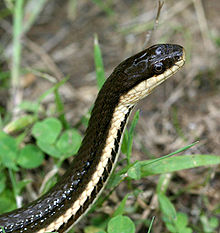
The queen snake (Regina septemvittata) is a species of nonvenomous semiaquatic snake, a member of the subfamily Natricinae of the family Colubridae. The species is endemic to North America. (Full article...)Image 17Full article...)Image 18neurotoxins (dendrotoxins), cardiotoxins and fasciculins. Some consider this species not to be a particularly aggressive snake, but others have suggested that they are extremely nervous and are prone to attack aggressively when cornered. Conflict with humans is low compared to some other species found in the region. Bites to people by this species are quite uncommon. Their mortality rate, however, is high; many of the recorded bites have been fatal. Rapid progression of severe, life-threatening symptoms are hallmarks of mamba bites. Bites with envenomation can be rapidly fatal. (Full article...)Image 19Full article...)Image 20Full article...)Image 21Full article...)Image 22Full article...)Image 23pet trade. (Full article...)Image 24Full article...)Image 25Full article...)Categories
Topics
Major extant reptile cladesLepidosauria Archelosauria Archosauria Associated Wikimedia
The following Wikimedia Foundation sister projects provide more on this subject:
-
Commons
Free media repository -
Wikibooks
Free textbooks and manuals -
Wikidata
Free knowledge base -
Wikinews
Free-content news -
Wikiquote
Collection of quotations -
Wikisource
Free-content library -
Wikiversity
Free learning tools -
Wiktionary
Dictionary and thesaurus
- What are List of portals

